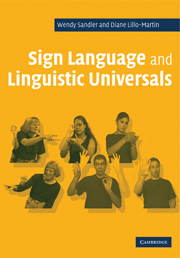Book contents
- Frontmatter
- Contents
- Preface
- Notation conventions
- UNIT I INTRODUCTION
- UNIT II MORPHOLOGY
- UNIT III PHONOLOGY
- 8 Meaningless linguistic elements and how they pattern
- 9 Sequentiality and simultaneity in sign language phonology
- 10 Hand configuration
- 11 Location: feature content and segmental status
- 12 The non-dominant hand in the sign language lexicon
- 13 Movement
- 14 Is there a syllable in sign language?
- 15 Prosody
- 16 Phonology: theoretical implications
- UNIT IV SYNTAX
- UNIT V MODALITY
- References
- Index
8 - Meaningless linguistic elements and how they pattern
Published online by Cambridge University Press: 05 June 2012
- Frontmatter
- Contents
- Preface
- Notation conventions
- UNIT I INTRODUCTION
- UNIT II MORPHOLOGY
- UNIT III PHONOLOGY
- 8 Meaningless linguistic elements and how they pattern
- 9 Sequentiality and simultaneity in sign language phonology
- 10 Hand configuration
- 11 Location: feature content and segmental status
- 12 The non-dominant hand in the sign language lexicon
- 13 Movement
- 14 Is there a syllable in sign language?
- 15 Prosody
- 16 Phonology: theoretical implications
- UNIT IV SYNTAX
- UNIT V MODALITY
- References
- Index
Summary
The preceding unit demonstrated that the lexicons of sign languages are rich and diversely structured, containing lexemes and bound morphemes, mechanisms of derivational and inflectional morphology, of incorporation and compounding. In all of these ways, one may naturally compare the words of sign languages with those of spoken languages. But in spoken languages, there is a level of structure beneath the word and the morpheme, a meaningless level, consisting of patterns of sounds. The form and organization of these sounds are constrained in part by the physiology of the oral–aural systems that produce and perceive them. Obviously, one would not expect to find equivalence in the formational units of a different modality. At the same time, there are principles of organization and alternation found at this level that are more abstract than those aspects of the system that can be described on the basis of physiology alone, principles which are in the domain of phonological theory. And it is here, at the level of analysis that abstracts away from the physical system to some extent, that we may look for similarities between the two modalities.
Until quite recently, sign languages were assumed to exist without a meaningless level of structure at all. As we explained in Chapter 1, it had been widely assumed that signs were essentially iconic wholes. It took the work of William Stokoe to demonstrate systematically that there is indeed a level of sign language structure that corresponds to phonology (Stokoe 1960, Stokoe et al. 1965).
- Type
- Chapter
- Information
- Sign Language and Linguistic Universals , pp. 113 - 119Publisher: Cambridge University PressPrint publication year: 2006



